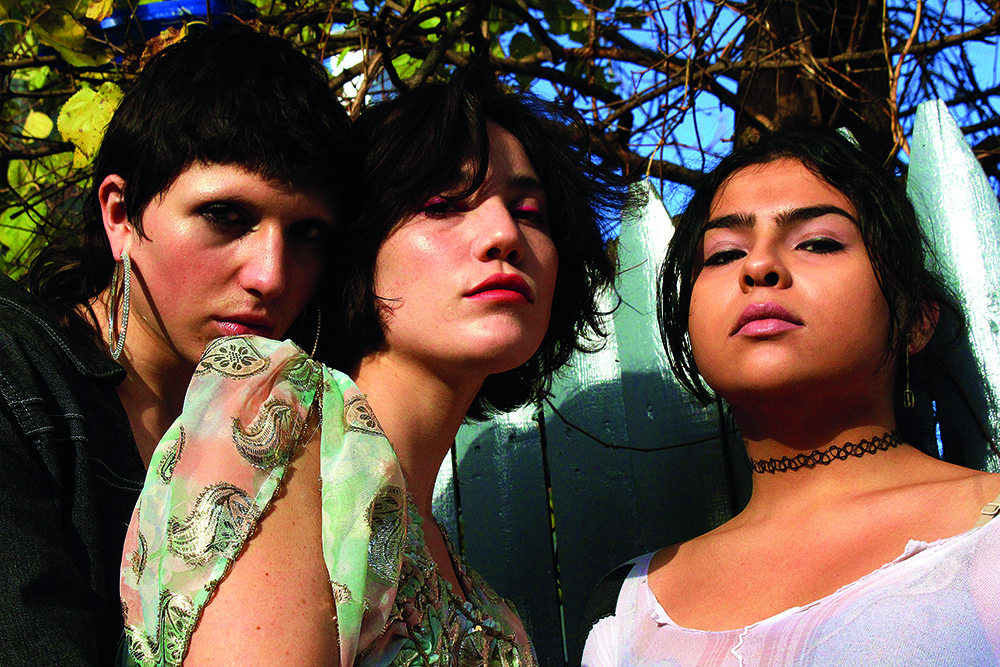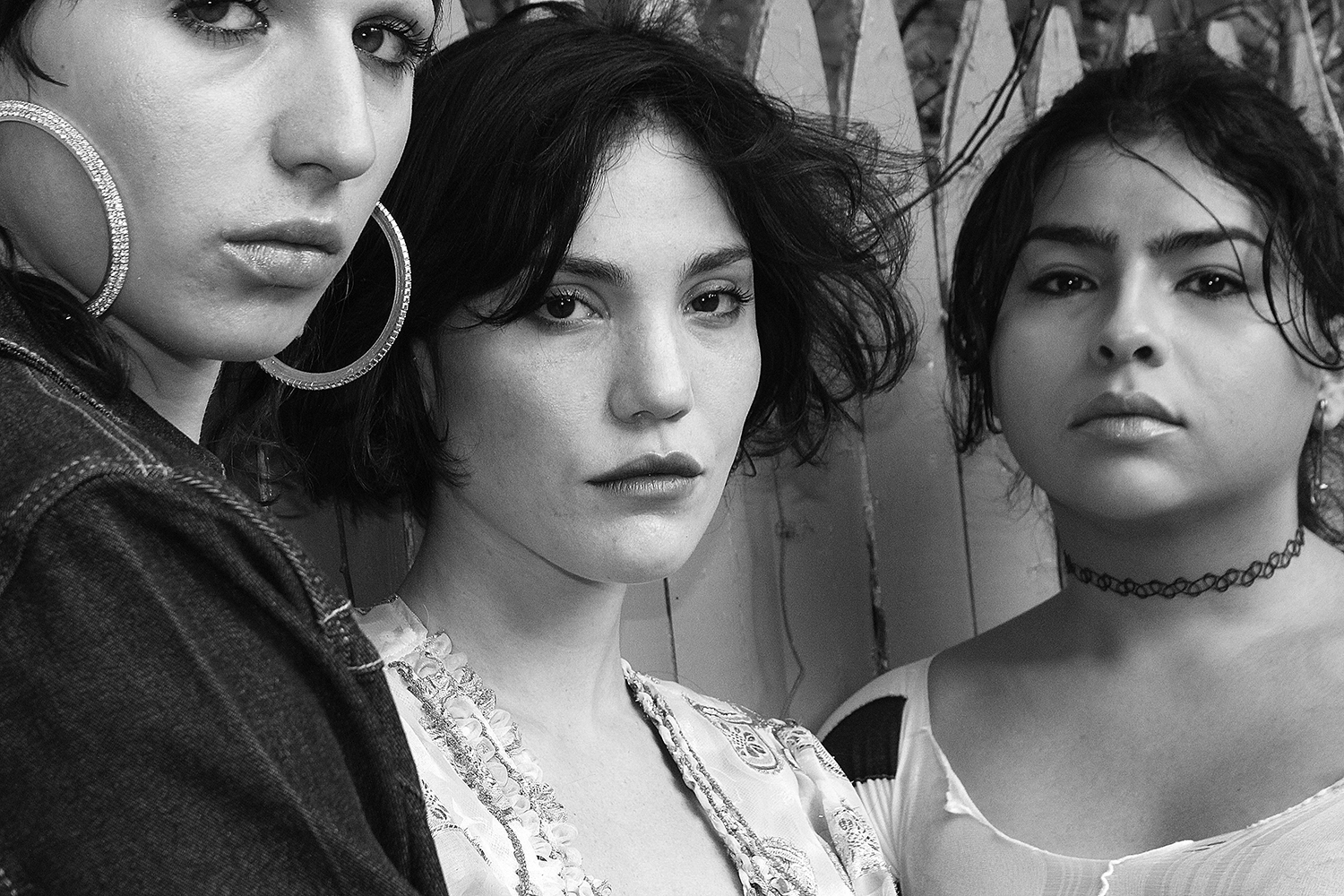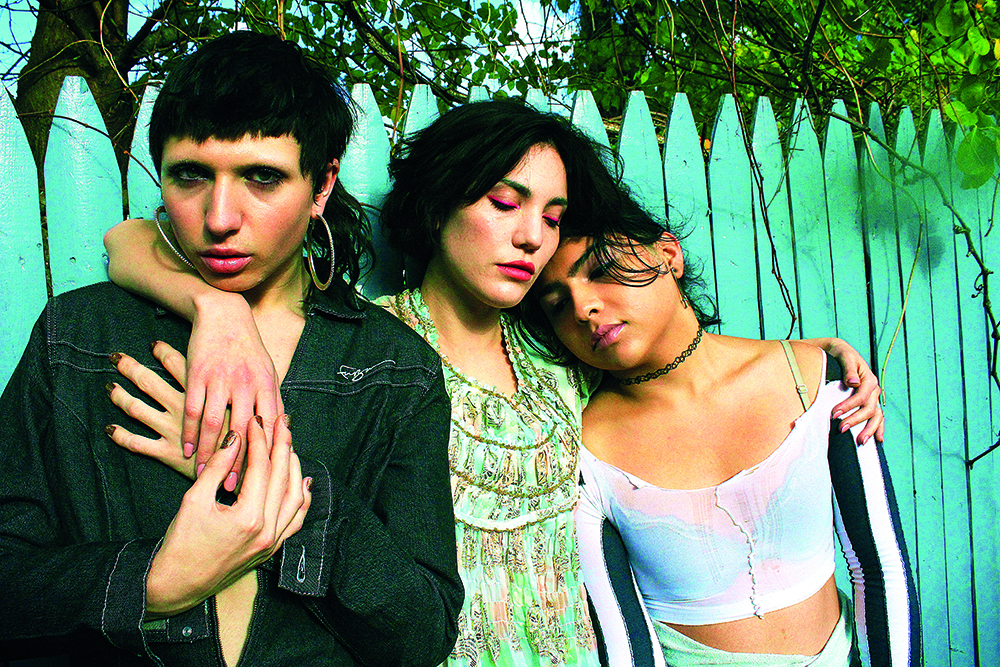Text and Photographs by Adam Lehrer
Ser Brandon-Castro Serpas is a young artist and poet perhaps best known for converting her drawings of body parts (limbs, sex organs, the works really) into sculptures. Daniela Czenstochowski is an artist and music producer that combines the disciplines of fashion design, sculpture, music and performance to create unnerving and strangely beautiful performance and video projects. Gia Garison is a classically trained actress and performer. Together, they are Swarovski Crystal Meth.
Swarovski Crystal Meth came into fruition last summer when artist Alexandra Marzella curated the “Selkie Series” for National Sawdust, compiling projects by a large group of likeminded artists and friends. Ser, Daniela and Gia didn’t know each other that well, but all were equally unnerved when asked to do a piece around the theme of “trans issues in America." Ser and Gia are trans women, but refuse to have their identities capitalized on or turned into a “mood board,” as Ser succinctly described her feelings about the curator’s request. Instead, Swarovski Crystal Meth became an intuitively fluid cross section of its various members' creative disciplines. There were elements of Ser’s poetry, Daniela’s music, and Gia’s method acting and performance. During the show, Swarovski Crystal Meth and its three members entered into states of simultaneous vulnerability and empowerment; consuming fruit, gesturing odd movements, and playing Daniela’s composition of the trio’s contorted vocal stylings.
What most fascinated me about the project was its refusal to embrace the social justice and victimhood narrative that was being pushed upon the group by the curators. Instead, it became a forceful expression of the beauty achieved through the intersectionality of multiple creative voices. These three women are all unique artistic talents with remarkably developed aesthetic identities, but Swarovski Crystal Meth folded a new layer into the practices of all three of the young artists.
LEHRER: How did the three of you come together to conceptualize this project?
DANIELA CZENSTOCHOWSKI: Well, it was organized by Alex [Marzella] for the show she curated [National Sawdust “Selkie” Series. She called all of these artists she’d met that she admired.
GIA GARISON: She wanted to showcase people other than herself and left it open to do whatever we wanted to do. We started to linger towards the idea of motherhood and birthing and the womb. Kind of these safe, warm spaces where we could all be together as one.
LEHRER: And in the beginning you knew you wanted to combine poetry with the other mediums?
GARISON: Ser writes a lot so we definitely wanted to incorporate that. Daniela’s great at mixing music so we wanted to use that. We wanted to use my fashion concepts. We all had different ways to put in our two cents.
CZENSTOCHOWSKI: Considering the small amount of time we had, we really had to jump into something that was quite intuitive and immediate.
GARISON: Exactly, there was no resting on it. It was in this really guttural way. For the sound of it we wanted it to be the very basic sounds of the body responding to stuff.
SER SERPAS: Heartbeats.
LEHRER: What is it about the womb that is so attractive as a concept to explore?
CZENSTOCHOWSKI: We all began in the womb. It’s the only thing we can all truly say we have in common. We are looking for this comfort, for this warmth, this environment that will tell us that everything will be okay.
LEHRER: And the womb is the only place where you really get that throughout your lifetime. The only true “safe space,” so to speak.
CZENSTOCHOWSKI: Right. We still look for comfort in so many ways. We still guard ourselves in comfortable places. The idea of dealing with discomfort was one of the biggest parts of this experience: us being naked, eating fruits, taking off our costumes, throwing out the sounds we made.
GARISON: I think also the idea of being birthed or re-birthed, even, is something we all deal with in a way, being femme. I mean, for me and Ser, being trans is an experience of a literal rebirth of who you are, of your identity. Then, being a woman in general means breaking away from the masculine stereotype that’s forced upon you. And that’s something we wanted to explore.
SERPAS: [We went through] a progression of movements and actions that we discovered while trying to figure out what we wanted to be doing.
LEHRER: How long did it go on for? That part of the performance.
CZENSTOCHOWSKI: About six minutes. We made costumes where we placed different types of food inside and then we had stuffed them with white stuffing. We hand-sewed and created our own designs based on what we wanted to identify ourselves with. It was amazing to see.
LEHRER: When you guys are doing this performance and concept together and showing it to other people immediately in your circle, or artists of your generation, does it create an anxiety when showing it to people maybe outside of that immediate circle?
SERPAS: It wasn’t our intention to imbue the performance with a strong message. It was more just for the audience’s perception. But it’s not like we were pushing to make the audience perceive it. It was open to interpretation. Going into it we were literally told to do “some trans American shit.” So, first of all, that took me by surprise and I didn’t like that. We don’t have to show that we are who we are to prove or do anything. You should already take everyone as the same no matter who they are, so we don’t have to show you that.
CZENSTOCHOWSKI: That [instruction] triggered the whole concept.
SERPAS: We rejected everything we were told because we didn’t agree with it. We felt the instructions were harsh so we didn’t even deal with it. It’s not like trans issues haven’t been around for our entire existence. If you don’t really know about them by now, you’re already lost and behind.
LEHRER: I think that with a lot of art shows’ curatorial strategies these days, there’s almost always a marketing ploy behind it.
GARISON: We don’t want that. So we just said, “No, fuck that, we’re going to do our own thing and you’re going to like it.” And we did and I think that by rejecting the whole issue we were told to base this on in the first place, it really made our performance stronger.
CZENSTOCHOWSKI: We all demonstrated the same need, struggle and search for stimulus that is inherently built within us. Regardless of our desires and aspirations and needs and wants and identities, we still all look for this place of comfort.
SERPAS: We all deserve that space to not be called out. We can’t be messy in public. It’s like turning up the brightness on something that’s already well enough lit that it doesn’t even need more lighting.
GARISON: Everybody sees it. Trans people are hyper visible and hyper invisible to the state in a lot of ways and both realities make us targets.
LEHRER: Your friend upstairs said to me, which made a lot of sense, the whole visibility issue in fashion and the art world is more problematic than not because that visibility can make the individual more susceptible to danger.
SERPAS: Yeah, I mean at the end of the day it’s just that trans talent rarely gets paid. With the creative industries in the states there’s this gap that’s very much supposed to be there to make sure there are people who can’t really do anything and don’t have a clear inspiration or position and trans people just end up on the mood board.
LEHRER: Right, and it seems like true inclusiveness wouldn’t just be featuring someone in a magazine it would be—
SERPAS: It would be support for the communities.
LEHRER: So are you all going to keep doing projects together?
CZENSTOCHOWSKI: I’d love to.
SERPAS: We haven’t planned anything but I feel like we will and should because we know how great we work together. It was honestly an experiment for me because I’d never really done this before either.
CZENSTOCHOWSKI: Summer camp!
SERPAS: Yeah, it was literally like summer camp for two weeks.
CZENSTOCHOWSKI: Ser’s poem was absolutely beautiful.
LEHRER: I love that you incorporated poetry because poetry has become the most ostracized creative medium in the digital era. So to incorporate it in a way, using visual and performative elements, feels very contemporary and relevant.
SERPAS: Yeah, that’s the thing that I’m very excited to keep exploring for future collaborations. It was so groundbreaking for me to see that these things could fit together. Years back, I didn’t think that this was possible.
GARISON: I think it’s finally, hopefully, making it’s way back in. I have always been one for a good poem.
CZENSTOCHOWSKI: We’re actually putting so much thought behind every step that is taken. And I guess that is a level of seriousness that I’ve come to see; for example, seeing a lot of contemporary art in North America compared to South America, much of the work up here is sarcastic or ironic or containing a humor and a subsequent negation to reality. A lot of South American art now is direct and obvious in its intention. There is suffering in it. So, I feel that at times when we performed we got feedback from people being like, “it was so funny to see your performance.”
LEHRER: Because that’s what they’re used to.
CZENSTOCHOWSKI: Because that’s what they’re used to; they thought it was a joke.
GARISON: We just wanted to be truthful. And I think we each found that, or at least tried to find that. We were always thinking about that while we were performing.
CZENSTOCHOWSKI: Definitely, and all sorts of feelings that came up in those moments were very real. The honesty of it was very real. We felt euphoric.
•




